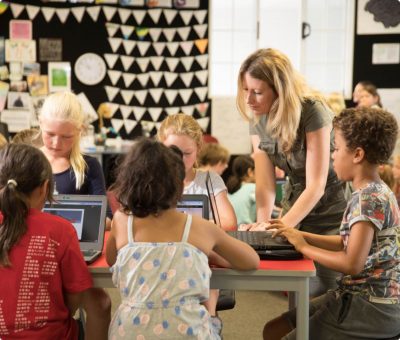5 Tips for Teachers in Innovative Learning Environments
By Editor on June 29, 2021 in Student agency
Innovative learning environments (ILE) are popping up all around Christchurch.
It is becoming increasingly rare for a teacher to work in a “single cell” classroom space with one group of students (Keehan and Forbes, 2020). ILE require teams of teachers to work together with a larger group of students.
Prior to joining Evaluation Associates, I was a middle leader and teacher. I worked collaboratively with three teachers, four teacher aides and 90 students in a new, purpose-built ILE space. We had breakout rooms for small groups of students to work in, funky furniture, and the students’ personal favourite – underfloor heating for the cooler winter days. However, ILE are so much more than just looking like a 21st Century classroom. They are about the collaborative pedagogy, systems and practice which sit behind the fancy physical environment that makes them effective.
After living and breathing ILE for the past six years, I have come to realise some top tips for teachers who may be beginning their journey towards ILE or have gone full circle. So, from my experiences, what advice and tips would I give myself now?
1. Build trusting relationships
“Trust involves tangible, actionable behaviours that can be evidenced in our everyday interactions” (Covey, 2006 as cited in Dalton, 2011). I have found that taking opportunities early on to establish and maintain trusting relationships with your collaborative teachers is vital for success. Joan Dalton’s (2011) work on actions that engender trust is a great starting place:
demonstrate respect
show genuine care
maintain your integrity
be transparent
be a learner: rectify mistakes
show loyalty
clarify expectations, goals and accountabilities
practise accountability
address the unacceptable
keep commitments
extend trust.

2. Be open to new learning
There is the age-old proverb, “two heads are better than one.” Teachers have different ways of providing quality teaching and learning. Personally, I believe you are actively participating in the one of the best forms of professional learning and development as you informally observe one another’s practice daily. The shared encounter of observation provides an opportunity for professional conversations by sharing insights, asking questions, and learning with and from one another (Timperley, 2015). Observations also promote modelling good teaching practice and enable the development of a shared understanding amongst colleagues of effective teaching practices that have an impact on student achievement.
3. Utilise the space
Spaces are an enabler that allow you to set up learning experiences and opportunities that you simply couldn’t do in a single cell classroom. Have initial discussions about expectations with your tamariki and revisit these regularly. Ask key questions such as:
What ways do students and teachers learn and work together?
1:1
1:some
1:many
Setting mutually agreed expectations of learning behaviours with your students helps to utilise the space effectively. If you do not, you may find yourselves playing good cop, bad cop without even knowing. Just like parenting, either you or your collaborative teachers end up being the “tough” teacher, and this can hurt your relationships. It can also send your students conflicting signals.
4. It’s all about “we” as a team
Harnessing a “we” identity is required for true collaboration (Keehan and Forbes, 2020). A partnership between colleagues of shared responsibility and moral purpose for all students is a shift in thinking. Teachers and students move away from the single cell mindset of one teacher and approximately 30 students in their class. Focusing on what “we” all do is beneficial especially when you utilise teacher strengths and abilities across your ILE. An example from my experience is one of my colleagues had a phenomenal way of challenging students in her learning-focussed relationships especially when teaching writing. We were able to learn from our colleague, our writing programme flourished, and we raised student achievement.
5. Remember it is a gradual process.
Collaborative teaching is complex and challenging. Therefore, it is important to remind yourself that “Rome wasn’t built in a day”. Beginning collaborative teaching in an ILE is all about short term wins for long term gains. It’s not a sprint, it’s a marathon. Just as you would not go out and run 42.2km on your first day of marathon training, don’t set yourself unrealistic expectations when you move to an ILE. As a collaborative teaching team, set yourself short term goals. It might be changing your numeracy programme from your single cell approach to incorporating collaborative pedagogies. By breaking it down and focussing on manageable goals you will find in no time you will be just like a well-oiled machine.
References:
Dalton, J. (2011). Learning talk: build a culture. Hands On Educational Consultancy Pty Ltd.
Keehan, S. & Forbes, D. (2020). It’s a “we” thing: Five principles of collaborative teaching, with implications for school leadership. Set, 2, 18-23. https://doi.org/10.18296/set.0171
Timperley, H. (2015). Professional conversations and improvement-focused feedback. A review of the research literature and the impact on practice and student outcomes. Australian Institute for Teaching and School Leadership (AITSL).
Keen to find out more? Contact
Other articles you might like
I am the new kid on the block at Evaluation Associates | Te Huinga Kākākura Mātauranga.
What do our littlest learners really need?
I struggle to understand why science is very largely absent from primary school teaching.
